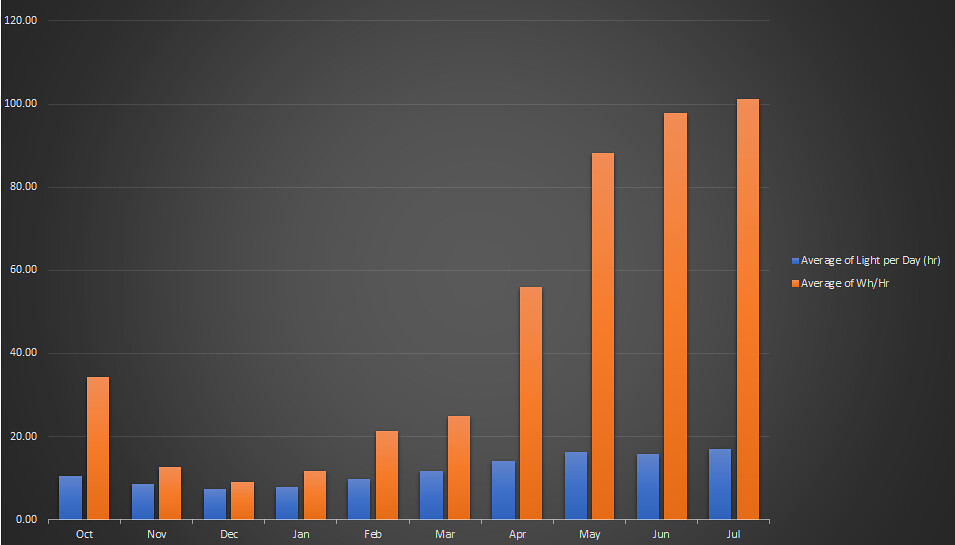harrow
Forum Member
where a generator as
a regular battery boost charge (say every 3 or 4 days)and as back up
makes sense.
Or tap into a local street light
where a generator as
a regular battery boost charge (say every 3 or 4 days)and as back up
makes sense.
Or tap into a local street light
I'll say this very, very quietly ... but I'm going to fit an Efoy device later in the year.
Now I am full-timing, never using campsites and hating the noise and inconvenience of a generator, this is the right answer for me.
I am north of the Border in fact.Wildebus' really useful graphs seem to suggest that his 400W of solar panels produce 100 watt hours per hour in Summer, 10 watt hours per hour in Winter.
Multiply those figures by 24 to get the per day figure, then divide by four hundred to get the "sun hours per day" figure. Or just multiply by 0.06 for ease of maths.
That gives 6 hours output in the best month, 0.6 hours output in the worst. That's slightly better than I'd expect (5) in June, rather less good than I'd expect in December, but he has mentioned being in some shade.
Is Wildebus mostly a creature of the South of the UK? That might explain the 20% better than expected Summer figures
Ok, Graph as promised:
but first ....
1) This is not a scientific analysis (I don't drive around in a Laboratory!) and should be read more as a Comparision between different months and as an example of a single install.
2) I park just north of a 3-storey house so the impact of a low sun angle is exacerbated by that building. If I were to park just 5 feet further north-east, my harvesting increases noticably - even in the Summer, but more so in Winter (confirmed by occasional testing) - so IMO the difference shown between Winter and Summer is more extreme than it has to be
3) The Length of Day is determined by the time the Controller spends in either Bulk or Absorption Mode (it doesn't really harvest in Float Mode and definately not when Off!)
Plus - The Victron MPPT Controller is very efficient and attempts to harvest at first light and this is much earlier than real energy harvesting will occur.
This means the number of hours of Light/Day is a bit exaggerated really. For example, the average daylight hours in December, the shortest month is still 7.34Hrs! and in June, the longest month, it was 17.41Hrs. As a specific example, yesterday the Solar Controller turned on at 04:47 and turned off at 21:56 - but actual proper harvesting (over 5% of capacity) didn't start until 07:30 and stopped at around 20:30 - A pretty big difference.

SolarChart by David, on Flickr
So for the 10 months shown, difference between Winter and Summer is at a factor of 10 (this is more extreme then reality for reasons explained above).
Bearing in mind the elongated daylight times and the parking location pull the numbers down significantly, I harvest around 25%/Hr of the nominal maximum capacity of my array in the summer but just 2.5% in Winter.
My feeling is that those numbers are more likely to be 45% Summer, 8% Winter with true harvesting hours and optimized parking, so if that is true, 8% in winter will do as a 'tickover' kind of level, but to really USE your camper, either EHU or a Split-Charge (or Alternator) will need to be in place I would say.
On my 400W Array, I currently tend to average around 1Kw/Day when I am not doing much in it, and around 2.2Kw/Day when the Controller doesn't hit float mode for very long.
I'll say this very, very quietly ... but I'm going to fit an Efoy device later in the year.
Now I am full-timing, never using campsites and hating the noise and inconvenience of a generator, this is the right answer for me.
Thinking about it some more, I've realised that as your figures only cover less than a year, the June numbers would be rather better than you'd expect, because June was rather sunnier than the usual sort of a June.I am north of the Border in fact.
The noise level is right, the installation cost is OK, but the running cost is ridiculous. You may as well burn fivers as a heat source - and they're more easily available.I'll say this very, very quietly ... but I'm going to fit an Efoy device later in the year.
Any 'green' environmental benefits attributable to a fuel cell @ 100W-150W will be fairly
marginal when weighed against the minimum +1kW output of the fossil fuelled generator
or gas/diesel space heater that would be required. Still to some silence is golden and that
combined with avoiding a possible smack in the face for running a noisy generator, the
high costs associated with running a fuel cell might be a price well worth paying
My point was that it's greener using an Efoy than running a generator ...
